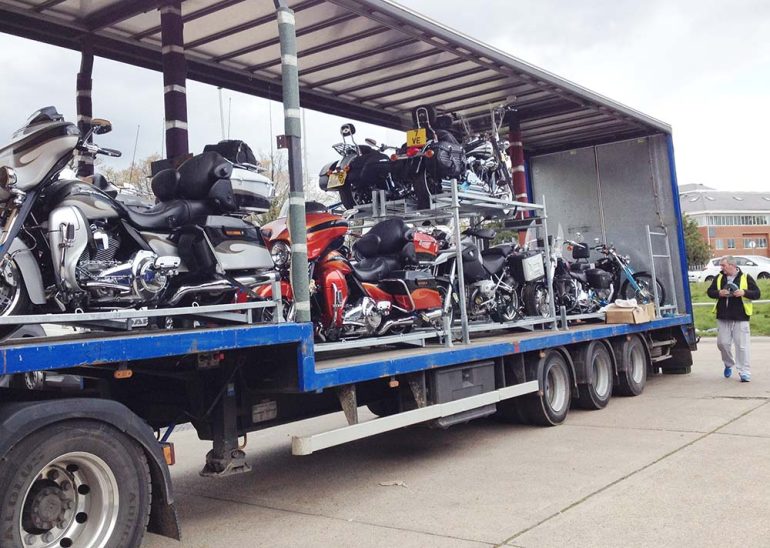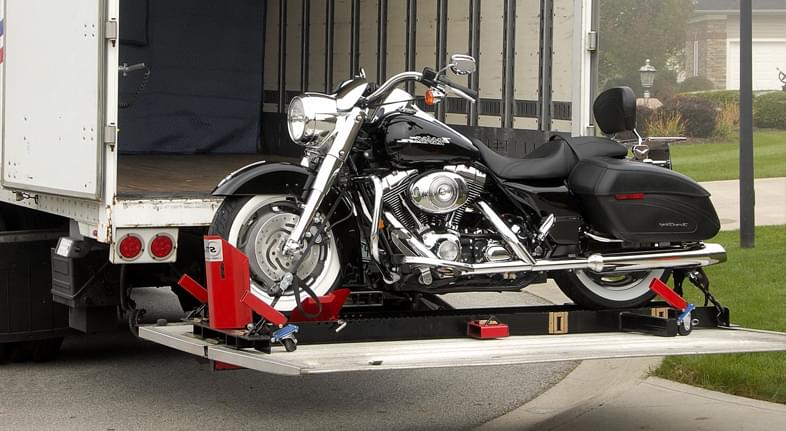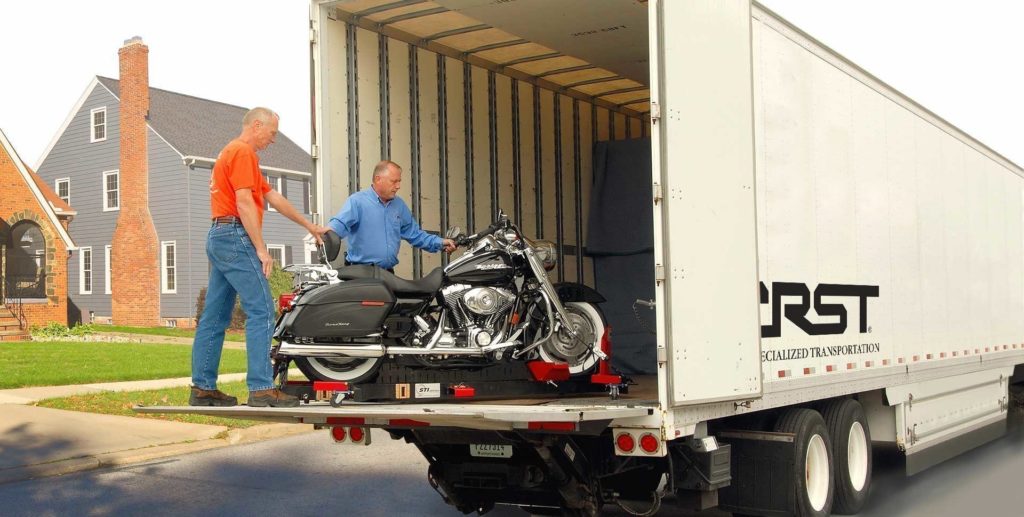How To Properly Tie Down a Motorcycle for Transport (Complete Guide)
Welcome to our article on how to properly tie down a motorcycle for transport. Whether you’re moving your bike to a new location or taking it on a road trip, it’s crucial to secure it safely to prevent any damage or accidents during transit. In this guide, we will walk you through the step-by-step process of securely tying down your motorcycle on a trailer or in a truck bed. From choosing the right tie-down equipment to identifying the proper attachment points, we’ll cover everything you need to know to ensure a secure and worry-free journey for your beloved bike. Let’s dive in!
Transporting a Motorcycle Basics
Transporting a motorcycle requires careful planning and attention to detail to ensure a smooth and safe journey. Whether you’re moving, selling, or taking your bike on a long-distance trip, understanding the basics of motorcycle transport is essential. A trustworthy transportation can be really helpful in this arena. Here’s how you choose a reliable and trustworthy shipping company.
Firstly, choose the right method of transport. Options include towing on a trailer, using a motorcycle carrier, or hiring a professional motorcycle shipping service. Consider factors such as distance, budget, and convenience when making your decision.
Next, prepare your motorcycle for transport. Clean it thoroughly and inspect it for any pre-existing damages. Remove any loose or protruding accessories and secure any loose parts. It’s also recommended to document your motorcycle’s condition with photographs for insurance purposes.
Properly secure your motorcycle to prevent any damage during transport. Use sturdy tie-down straps or wheel chocks to keep the bike stable and prevent shifting. Distribute the weight evenly to maintain balance.
Ensure you have the necessary paperwork, such as the vehicle registration, insurance, and any required permits or documentation for interstate or international transport.
Lastly, communicate effectively with the transport service provider. Provide accurate pickup and delivery locations, and discuss any specific requirements or instructions.
By following these basics, you can ensure a successful motorcycle transport experience. Whether it’s a short journey or a cross-country trip, taking the necessary precautions will help protect your motorcycle and give you peace of mind throughout the process.
Transporting a Motorcycle With Tie-Downs
Transporting a motorcycle with tie-downs is a popular and effective method that ensures the bike’s stability and safety during transport. Whether you’re moving, selling, or transporting your motorcycle for any other reason, understanding how to properly use tie-downs is crucial. Read this blog and know more about how to transport a motorcycle.
Firstly, ensure you have the necessary equipment: high-quality tie-down straps, soft loops, and a suitable trailer or truck bed. It’s recommended to use at least four tie-down straps for added stability.
Start by positioning your motorcycle on the trailer or truck bed, making sure it is centered and balanced. Attach the soft loops to sturdy points on the motorcycle, such as the handlebars or the frame.
Next, secure the tie-down straps to the loops and anchor points on the trailer or truck bed. Ratchet the straps snugly, but not overly tight, to compress the suspension slightly and keep the bike in place. Avoid over-tightening, as it may damage the motorcycle.
Double-check that all straps are secure and free from twists or tangles. It’s advisable to periodically inspect the straps during transport to ensure they remain tight and secure.
When unloading the motorcycle, start by releasing the tension on the straps gradually, one at a time. Carefully remove the straps and soft loops, ensuring no part of the motorcycle is caught or damaged in the process.
By following these guidelines and using proper techniques, you can transport your motorcycle with tie-downs safely and securely. However, if you’re unsure or prefer professional assistance, consider hiring a reputable motorcycle shipping service for added peace of mind.
Recommended Tie-Down Points on Larger Motorcycles
When it comes to transporting larger motorcycles, ensuring proper tie-down points is essential to maintain stability and prevent any potential damage during transport. Here are some recommended tie-down points to consider:
- Frame: The frame is a strong and stable point for securing your motorcycle. Look for solid and rigid sections of the frame near the front and rear of the bike.
- Triple Tree: On bikes with a front suspension fork, the triple tree area provides a secure tie-down point. Use soft loops around the upper part of the triple tree and attach the tie-down straps to them.
- Passenger Footpegs: Many larger motorcycles have sturdy passenger footpegs that can serve as reliable tie-down points. Attach the straps to these points, ensuring they are securely fastened.
- Subframe: Some motorcycles have a subframe located at the rear, which provides additional support. Check your motorcycle’s manual or consult with a professional to identify suitable tie-down points on the subframe.
- Swingarm: On bikes with a solid swingarm, you can utilize this component as a tie-down point. Make sure to attach the straps in a way that doesn’t interfere with the suspension movement.
Always refer to your motorcycle’s owner manual for specific tie-down points and guidelines. Additionally, using soft loops around the tie-down points will protect your motorcycle from scratches or damage caused by direct contact with the straps.
Remember to distribute the tie-down points evenly to maintain balance during transport. It’s also crucial to use high-quality tie-down straps and ensure they are tightened securely, but not excessively, to avoid unnecessary stress on your motorcycle.
By following these recommendations, you can transport your larger motorcycle with confidence, knowing that it is securely fastened and protected during the journey.
How To Tie Down a Motorcycle
Tying down a motorcycle properly is crucial to ensure its stability and safety during transport. Here are the basic steps to tie down a motorcycle securely:
- Positioning: Park the motorcycle on a level surface and ensure it is in a stable position.
- Attach Soft Loops: Loop soft straps around solid parts of the motorcycle, such as the handlebars, forks, or frame. These loops will serve as anchor points for the tie-down straps.
- Attach Tie-Down Straps: Connect the tie-down straps to the soft loops, ensuring they are snug but not overly tight.
- Compression: Gently compress the suspension by applying downward pressure on the motorcycle while tightening the tie-down straps. This helps stabilize the bike and prevents excessive movement during transport.
- Double-Check: Once the straps are secure, double-check all connections and ensure they are tight and properly aligned.
Always refer to the motorcycle’s owner manual for specific tie-down points and guidelines. Additionally, using high-quality tie-down straps with sufficient strength and ratcheting mechanisms is crucial for secure transportation.
By following these steps, you can confidently tie down your motorcycle, ensuring it remains stable and protected throughout the journey.
Things You Should Know
When it comes to transporting a motorcycle, there are several important things you should know to ensure a smooth and safe process. Here are some key points to consider:
- Research: Before choosing a motorcycle transport service, do thorough research. Look for reputable companies with positive customer reviews and a track record of reliability.
- Insurance: Check if the transport company provides insurance coverage for your motorcycle during transit. It’s crucial to have adequate protection in case of any damage or loss. Read this article to get a clear idea about vehicle insurance policy
- Preparation: Prepare your motorcycle for transport by cleaning it, removing any loose accessories, and documenting its current condition with photographs.
- Communication: Maintain open communication with the transport company to stay updated on the shipping process and delivery timelines.
- Documentation: Ensure you have all the necessary documentation, such as proof of ownership, insurance papers, and any required permits.
- Cost and Payment: Understand the cost involved in transporting your motorcycle, including any additional fees. Clarify the payment terms and methods accepted by the transport company.
By being well-informed and taking the necessary precautions, you can have peace of mind knowing that your motorcycle will be transported safely and efficiently.
Be prepared when the shipping company picks up your motorcycle. Here’s what to expect when your shipping company picks up your vehicle.
Steps
Step 1: Securing the Front Wheel
When it comes to tying down a motorcycle for transport, securing the front wheel is a critical step. Here’s how to do it:
- Position the motorcycle: Place the motorcycle in the desired position on the trailer or truck bed, ensuring it is stable and balanced.
- Attach the straps: Use high-quality ratchet straps or tie-downs to secure the front wheel. Place one strap around the front tire, near the fork or handlebars.
- Tighten the straps: Tighten the straps evenly, ensuring they are snug but not overly tight. This will help keep the motorcycle secure during transport.
- Check for stability: Gently rock the motorcycle to check for any movement. If it feels loose, readjust the straps and tighten them further.
- Double-check: Before hitting the road, double-check that the front wheel is securely tied down and there is no excessive play or movement.
By properly securing the front wheel, you can help prevent shifting or damage to the motorcycle during transportation, ensuring a safe and worry-free journey.
Step 2: Wrapping the Rear Tire
In the process of tying down a motorcycle for transport, wrapping the rear tire is an important step to ensure stability. Here’s how to do it:
- Position the motorcycle: Place the motorcycle in a balanced position on the trailer or truck bed, ensuring it won’t tip over during transport.
- Attach the straps: Take a high-quality ratchet strap or tie-down and wrap it around the rear tire, near the swingarm or frame.
- Secure the strap: Pull the strap tight and fasten it securely. Make sure it is snug but not excessively tight to avoid putting unnecessary pressure on the tire.
- Double-check: Give the motorcycle a gentle push or rock to ensure the strap holds it firmly in place.
By wrapping the rear tire, you add an additional layer of stability to the motorcycle during transport, minimizing the risk of shifting or damage. This step contributes to a safe and secure transportation process.
FAQs
What’s the Best Way To Tie Down a Motorcycle?
The best way to tie down a motorcycle for transport is to use a combination of front and rear tie-down straps. Start by securing the front wheel with a wheel chock or a front tie-down strap attached to a solid anchor point. Then, use rear tie-down straps to stabilize the motorcycle by attaching them to the rear part of the frame or swingarm. Make sure the straps are tight and secure, but not overly tight to avoid damaging the suspension. Using high-quality straps and following proper techniques will ensure the motorcycle remains stable and protected during transportation.
What Will Happen if a Motorcycle Is Not Tied Down Well?
If a motorcycle is not properly tied down during transport, it can result in dangerous consequences. Without secure tie-downs, the motorcycle may shift, tip over, or become unstable during transit. This can lead to damage to the motorcycle itself, as well as other vehicles or objects nearby. Moreover, inadequate tie-downs can pose a significant safety risk to the driver and other road users. It is essential to ensure that the motorcycle is securely and firmly tied down using appropriate straps and techniques to prevent accidents, damage, and injury.
How To Tie Down a Motorcycle on a Trailer Without a Chock?
When tying down a motorcycle on a trailer without a chock, you can still ensure its stability and safety. Start by attaching the front tie-down straps to sturdy anchor points on the trailer, such as the handlebars or the triple tree. Then, compress the front forks slightly by using a ratchet strap or by compressing the suspension manually. For the rear, attach the tie-down straps to the frame or the passenger footpegs and pull them tightly to secure the motorcycle. Make sure the straps are evenly tensioned and avoid over-tightening to prevent damage. Regularly check the straps during transport to ensure they remain secure.








